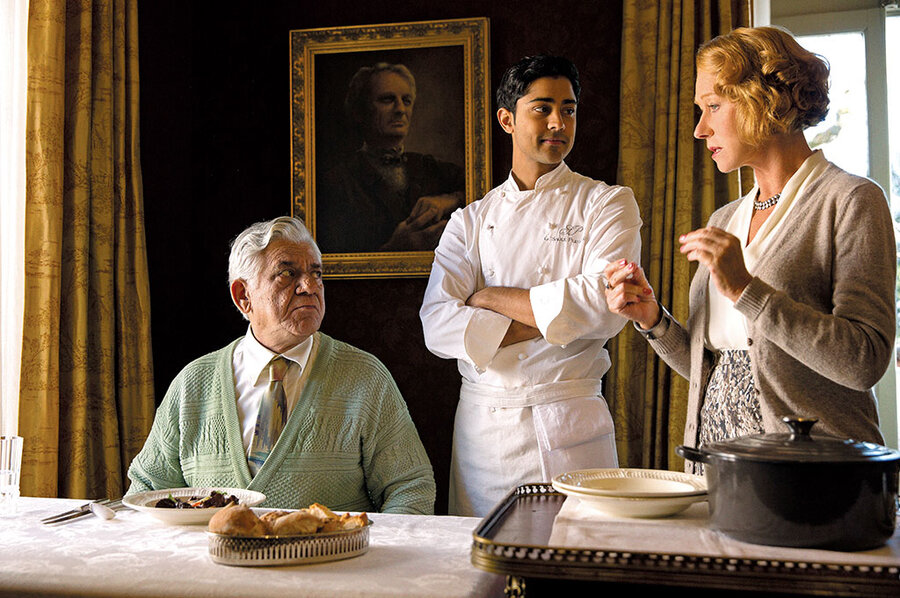'The Hundred-Foot Journey' is predictable but comforting
Loading...
Comfort food doesn’t always have to be food. Sometimes it can be a movie – especially if it’s a movie about food. “The Hundred-Foot Journey,” adapted by director Lasse Hallström and screenwriter Steven Knight from Richard Morais’s 2010 bestseller, is, I would imagine, nobody’s idea of a great film, but it serves up the pleasures of the obvious. You know where this movie is headed every foot of the journey, and that’s the point, the comfort. If only a few unforeseen byways had been part of the package.
As the film opens, a Mumbai family, headed by patriarch widower Papa Kadam (the unfailingly marvelous Om Puri), flees violent unrest and eventually settles in the Midi-Pyrénees region of France. There the decision is made to open a restaurant, the Maison Mumbai, similar to the family-run eatery back home. The biggest obstacle to success: Directly across the street – yes, 100 feet across – is the Michelin-starred Le Saule Pleureur, overseen by the widowed Madame Mallory (Helen Mirren at her most tight-faced), who suffers fools not gladly.
When it looks as though the provincial villagers are willing to give spicy Indian cooking a go, Madame sets out to sabotage Maison Mumbai, buying out key ingredients in the local market and hitting up the restaurant with all manner of nuisance lawsuits.
The fun here is that Papa gives as good as he gets. He’s every bit as stubborn as Madame, which, of course, means that somewhere down the line they will become close. This is the kind of movie in which characters are instantly pegged. Mirren’s Madame, for example, does not crack a smile once for the first hour of the film. This is a dead giveaway that she will be smiling a lot in the second hour.
The soggy center of the film belongs to Papa’s son Hassan (Manish Dayal), a gifted Indian chef who is entranced with French cuisine, and also with Madame’s pretty sous-chef Marguerite (Charlotte Le Bon).
When Madame, hungry for a second Michelin star, comes around to the unthinkable thought that Hassan just might be her ticket to greater glory, a bit of competitive tension is infused. But not much. Hassan may whip up sumptuous dishes but, as a character, he could do with a lot more spice.
The film touches on the ugly strain of racism in certain sectors of French society, but not enough to turn feel-good into feel-bad. About the most distressing thing that happens in the film is that Madame, before she overcomes her uppityness, rejects Hassan’s peace offering of pigeon with truffles.
Hallström, who also directed “Chocolat,” follows the foodie-cinema aesthetic by filming the dishes in a gleaming sumptuousness designed to make you famished. (Sidenote: To the eternal question of whether one should see these food movies on an empty stomach or a full one, I turned to a renowned restaurateur of my acquaintance and her answer came back: “Always eat dinner afterwards.”)
If these movies continue unabated – in just the past few months we’ve had “Chef” and “Le Chef” – we may see the return of Smell-O-Vision.
I wish the movie weren’t quite so sappy about the spiritually redemptive powers of fine cuisine. Sometimes a meal is just a meal. Apparently, according to this movie, the secret to making a great French sauce is the love you must “find in your heart.” By this token, all the great chefs of the world must be saintly and super-nice. There’s also a lot of talk about how “food is memories,” which I suppose is a step up from “Soylent Green is people,” but hasn’t anybody connected to this movie ever had indigestion?
And all this love stuff about food contradicts Madame’s naked ambition in going after yet another Michelin star. Still, speaking as a critic, albeit a movie critic and not a food critic (the difference between the two is diminishing), it’s nice to feel wanted. Grade: B- (Rated PG for thematic elements, some violence, language, and brief sensuality.)







